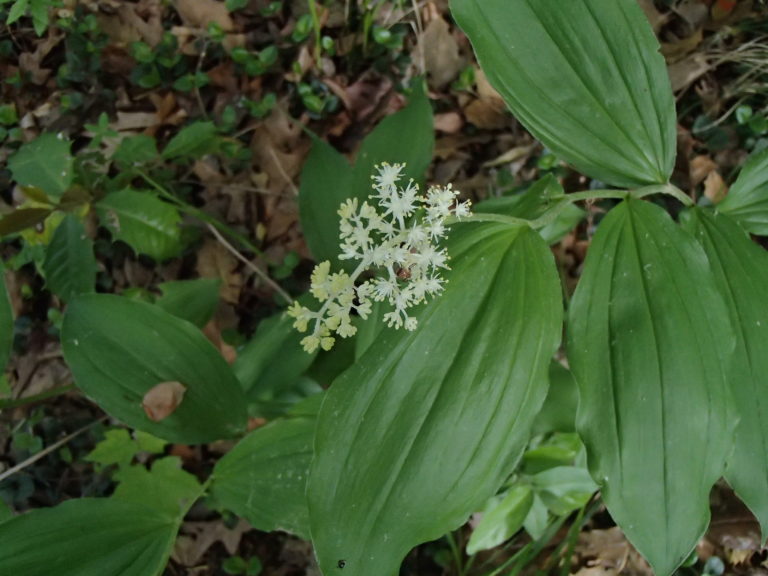Solomon’s Plume is a widespread perennial, reported in all of the U.S. mainland states, but conspicuously almost entirely absent from the coastal plain from NC down to Florida and over to Texas and throughout the great plains. It is abundant here in the piedmont, with gracefully arching, unbranched stems reaching up to three feet in length, growing in drifts in the forest understory inside our deer fence together with Solomon’s Seal, Partridgeberry and Coral Honeysuckle. The beautiful, leaves of the Solomon’s Plume, with their shiny veneer and parallel venation, are alternately arranged and distributed evenly along the stem. The delightfully fragrant flowers form a cream-colored plume at the end of the stems. The unripened berries of Solomon’s Plume are a creamy green color and ripening to reddish. Each plant gives rise to 5-6 others, resulting in their colonial habit. This is a wonderful plant for shaded southern woodland gardens. The berries are also widely eaten by birds and small mammals, making it important for wildlife. This plant has received the UK’s Royal Horticultural Society’s Award of Garden Merit.
NURSERY HOURS
Wednesday: 10-4 Thursday: 10-6 Friday-Saturday: 10-4 Sunday: 12-4
Maianthemum racemosum

Key Info
Scientific Name: Maianthemum racemosum (L.) Link
Common Names: False Solomon Seal, Feathery False Lily of the Vally, Solomon's ZigZag, False Spikenard, American Spikenard, Fat Solomon, Solomon's Plume, Smilacina, Treacleberry
Family Names: Ruscaceae (Ruscus Family)
Plant Type: Herbaceous perennial
Leaf Retention: Deciduous
Flower Color: Creamy white
Special Characteristics: Tolerates shade, Showy fruit, Flowers fragrant, Edible fruit (in jams), Rhizomatous
Additional Info
Habit: Arching somewhat zig-zag unbranched stems arising from stout, fleshy, persistent rhizomes with secondary fibrous roots. Each branched rhizome has one to several upright stems, no basal rosette. The plant typically grows 2-3' tall and slowly spreads, often forming large colonies in the wild.
Height: 1' to 3'
Spread: 1' to 2'
Soil Conditions: Prefers deep, loose humus-rich soils, acid pH, sandy, loamy, clay
Leaves: Each stem has 2 rows of alternate, oval, pointed, light green leaves 3-6 inches long, 1 - 2.5 inches wide, with conspicuously parallel veins, sessile on the upper portion, short petioled below. The foliage may turn yellow to gold in the fall, but sometimes just goes brown.
Flowers (or reproductive structures: In late spring and early summer feathery masses of small (¼” inch wide), white to pale yellow, fragrant flowers are produced in flat 4- to 6-inch panicles at the ends of the stems. Flower clusters can have between 20 and 80 individual flowers. Each star-shaped flower has 6 tepals, 6 stamens with yellow anthers and a central pistil. (wimastergardener.org/article/false-solomons-seal-maianthemum-racemosum/)
Fruit: Pinkish/tan or greenish berries with copper spotches ¼-inch wide, turn a deep, translucent ruby red in summer, often persisting into fall unless consumed by wildlife. Seeds 1–4.
Natural Distribution: Woods, clearings, slopes with partial shade and deep, moist, soft soils.
USDA Hardiness Zone: 3-8
USDA Wetland Indicator Status in NC: FACU
Pollination: The flowers are pollinated by small bees, flies, and beetles.
Wildlife Connections: Birds and mamals eat berries, deer eat leaves.
Propagation: By division or by seed (seeds show double dormancy, stratification treatments required).
